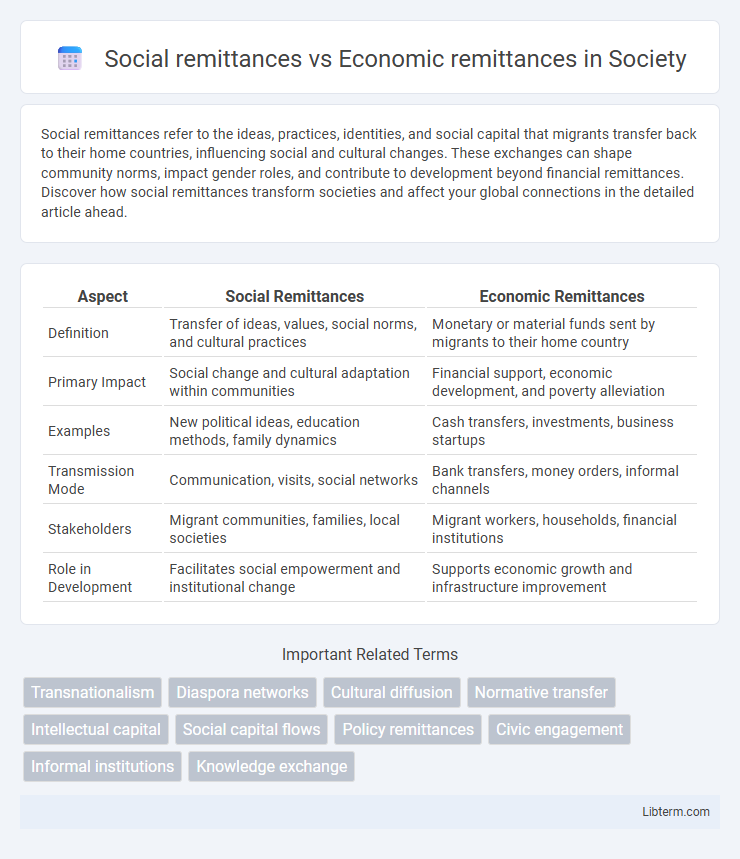Social remittances refer to the ideas, practices, identities, and social capital that migrants transfer back to their home countries, influencing social and cultural changes. These exchanges can shape community norms, impact gender roles, and contribute to development beyond financial remittances. Discover how social remittances transform societies and affect your global connections in the detailed article ahead.
Table of Comparison
| Aspect | Social Remittances | Economic Remittances |
|---|---|---|
| Definition | Transfer of ideas, values, social norms, and cultural practices | Monetary or material funds sent by migrants to their home country |
| Primary Impact | Social change and cultural adaptation within communities | Financial support, economic development, and poverty alleviation |
| Examples | New political ideas, education methods, family dynamics | Cash transfers, investments, business startups |
| Transmission Mode | Communication, visits, social networks | Bank transfers, money orders, informal channels |
| Stakeholders | Migrant communities, families, local societies | Migrant workers, households, financial institutions |
| Role in Development | Facilitates social empowerment and institutional change | Supports economic growth and infrastructure improvement |
Introduction to Remittances
Remittances encompass the transfer of money and intangible assets from migrants to their home countries, playing a crucial role in development. Economic remittances refer specifically to the financial resources sent by migrants, which support households, invest in businesses, and stimulate local economies. Social remittances consist of ideas, practices, skills, and social capital transferred alongside economic resources, influencing cultural norms, governance, and social structures in origin communities.
Defining Social and Economic Remittances
Social remittances refer to the ideas, behaviors, identities, and social capital that migrants transfer from host to home countries, influencing cultural norms and community practices. Economic remittances consist primarily of monetary funds sent by migrants to support households, stimulate local economies, and finance investments in origin communities. Distinguishing these remittance types clarifies their distinct impacts on socioeconomic development and transnational exchanges.
Key Differences Between Social and Economic Remittances
Social remittances encompass the ideas, behaviors, identities, and social capital that migrants transfer to their home communities, influencing cultural norms and social practices. Economic remittances refer to the financial resources sent by migrants to support household consumption, investment, and community development. The key differences lie in their impact scope: social remittances reshape social structures and values, while economic remittances primarily address material needs and economic growth.
The Role of Migrants in Transmitting Remittances
Migrants play a crucial role in transmitting both social and economic remittances, influencing development in their home countries beyond financial flows. Economic remittances refer to the monetary transfers sent by migrants, which contribute significantly to household incomes, poverty reduction, and local economic growth. Social remittances encompass the ideas, practices, skills, and social capital migrants transfer, shaping cultural norms, political attitudes, and community development in origin societies.
Impact of Economic Remittances on Local Economies
Economic remittances, consisting of monetary transfers sent by migrants to their home countries, significantly stimulate local economies by increasing household income, enabling investment in education, healthcare, and local businesses. These financial inflows often contribute to poverty reduction, improve living standards, and enhance economic stability in recipient communities. Studies show that consistent economic remittances can lead to higher consumption rates and promote small-scale entrepreneurship, fostering long-term economic development at the grassroots level.
Social Remittances: Shaping Cultural and Social Norms
Social remittances encompass the ideas, behaviors, identities, and social capital exchanged by migrants with their home communities, profoundly influencing cultural practices and social norms. These intangible flows promote changes in gender roles, education values, political participation, and health behaviors, facilitating social transformation beyond mere economic impact. By shaping attitudes and community dynamics, social remittances can lead to enhanced social cohesion and progressive cultural shifts in migrant-origin societies.
Comparative Analysis: Social vs Economic Contributions
Social remittances encompass the transfer of ideas, values, behaviors, and social capital from migrants to their home communities, influencing cultural norms and social development. Economic remittances refer to the monetary funds sent by migrants to support household income, investment, and local economic growth. Comparative analysis reveals that while economic remittances directly enhance financial stability and infrastructure, social remittances foster long-term societal transformation through education, governance, and community cohesion.
Challenges in Measuring and Valuing Social Remittances
Measuring and valuing social remittances presents significant challenges due to their intangible nature, encompassing cultural norms, ideas, and social capital transferred through migrant networks. Unlike economic remittances, which involve quantifiable monetary flows, social remittances require qualitative methods and ethnographic studies to capture their impact on social change and innovation in origin communities. The complexity of isolating social remittance effects from other socio-economic factors further complicates accurate assessment and policy formulation.
Policy Implications for Maximizing Remittance Benefits
Social remittances, encompassing the transfer of ideas, values, and social capital, interact with economic remittances--monetary transfers sent by migrants to their home countries--to shape development outcomes. Effective policy frameworks must integrate measures that not only facilitate secure and low-cost financial transactions but also support knowledge exchange, education, and community engagement to harness social remittances for transformative social change. Prioritizing the dual impact of these remittance types enables governments to design inclusive strategies that amplify economic growth while fostering social cohesion and sustainable development.
Future Trends in Social and Economic Remittances
Future trends in social and economic remittances indicate increasing integration of digital platforms, enhancing the speed and accessibility of both financial transfers and the exchange of social capital such as ideas and practices. The rise of blockchain technology and mobile money solutions is expected to reduce transaction costs and increase transparency in economic remittances, while virtual communities and social networks facilitate the flow of knowledge, cultural values, and social norms across borders. Migration patterns combined with advancements in technology will drive the convergence of social and economic remittances, amplifying their impact on development in origin communities.
Social remittances Infographic

 libterm.com
libterm.com